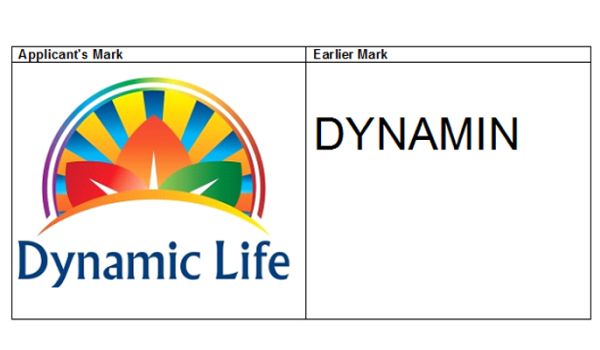
Matthias Werner applied to register as an EU trade mark (EUTM) a composite sign (above left) consisting of a brightly coloured figurative element suspended over the word elements "dynamic" and "life" for "dietary supplements for humans and animals; tobacco-free cigarettes for medical purposes; vitamin preparations; medicinal drinks (class 5) and "fruit beverages and fruit juices; fruit juice concentrates (non-alcoholic drinks); beer" (class 32). A Spanish company, Laboratorios Ern, SA, filed a notice of opposition based on a likelihood of confusion between the EUTM and the Spanish company's earlier Spanish word mark DYNAMIN, registered for "chemical products and specifics" (class 1) and "dietetic foods adapted for medical use in any shape or form" (class 5).
Both the Opposition Division and, subsequently, the EUIPO's Fourth Board of Appeal, rejected the opposition. The Board of Appeal found that only "medicinal drinks" covered by the EUTM and "dietetic foods adapted for medical use in any shape or form" covered by the Spanish mark were identical, with other goods covered being, at most, highly similar, and others not similar at all. Further, the Board considered the signs at issue to have a low degree of visual and phonetic similarity and no conceptual similarity. Given that the relevant public for certain of the goods, being consumers in Spain of goods for medical use, would have had a heightened level of attention and in light of the normal distinctive character of the Spanish mark, there was no likelihood of confusion.
On appeal, the EU General Court rejected the Spanish trade mark owner's argument that the goods were all identical, highly similar or at least closely related. In particular, the assertion that "tobacco-free cigarettes for medical purposes" were a dietetic foodstuff was ineffective as these goods were not in competition with each other and could not be used to prevent or treat the same conditions. Finally, while the goods might both have health benefits, they could not be considered complementary as the use of one was "neither indispensable [n]or decisive" for use of the other.
In a comparison of the signs at issue, the proprietor of the Spanish mark asserted that the word element of the EUTM, "dynamic", was the dominant feature of this mark. The General Court disagreed, however, finding instead that neither the brightly coloured figurative elements of the mark, nor the second word element, "life", were dominated by this first word element. Therefore the EUTM was considered as a whole when compared to the Spanish mark. The General Court agreed with the Board of Appeal that the signs had a low degree of visual similarity, particularly given the "striking figurative element" of the EUTM. In terms of phonetic similarities, the "n" at the end of DYNAMIN produced a very different sound to the "c" at the end of "dynamic". As this difference in pronunciation was accentuated by the pronunciation of the second word element in the EUTM, the signs at issue could only be considered to have a low degree of phonetic similarity.
Finally, as the Spanish mark was held to be "without meaning for the relevant public", the Board of Appeal had been correct to find that there was no conceptual similarity between the signs.
Both the Opposition Division and the Board of Appeal had been correct in concluding that there was no likelihood of confusion between the signs at issue. It therefore followed that the General Court rejected the appeal in its entirety and the opposition was rejected.
Case T-454/15
The content of this article is intended to provide a general guide to the subject matter. Specialist advice should be sought about your specific circumstances.

